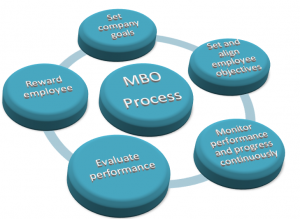MBO Helps in Reaching the Objectives
Management by objectives is a widely used vital concept to manage various situations in the organizations. It is an integrated system which can systematically direct the individual objectives towards the organizational goals. With the help of this concept, management can convey specific objectives to the members of the organization effectively; it facilitates a balance between the actual employee’s performance and pre-described standards of the organization. Management by objectives is a goal-driven management system used to fulfill the various areas in the organization such as strategic planning, human resource planning, production planning, performance appraisal, financial management, marketing, and budgeting etc.

The concept management by objectives is described as it is the process of identifying common goals of the employees and organization. Superiors and subordinates jointly set the objectives to be met and it helps in defining individuals major responsibilities and expected results for the contribution for the objectives of the organization.
Employees show commitment and work for the fulfillment of the common objectives and to meet the performance expectations, due to their own involvement in setting the objectives. It facilitates self-fulfillment and job satisfaction due to the empowerment and clarity in the goals what they have to achieve and major areas of responsibilities. It motivates the employees by giving a scope to decision making in various key managerial areas.
Management by objectives process
The process of management by objectives involves the determination of objectives of the organization, determination of individual objectives and the determination of individual targets and periodical reviews through performance appraisal and recycling. Finally, employees are awarded monetary or non-monetary incentives.
Determination of objectives of the organization
Usually, objectives are set by the top level managers and it flows through the hierarchy and finally reaches the individuals of the organization to assign the tasks. But in management by objectives process, both the superiors and subordinates participate in setting objectives for the efficient and effective achievement of the common goals.
Determination of departmental goals
Generally, objectives of various departments are set for the purpose of efficient achievement of their own department’s target, but without proper coordination and integration, it cannot fulfill the purpose of the objectives of the organization. So management by objectives set a clear path to maximize the success rate in attaining the common objectives.
Determination of individual targets
Assigning targets without proper job design creates confusions and errors in the performance of the employees. So the concept of MBO states that the employee participation in setting objectives maximizes the efficiency in performing tasks which are assigned to them. It acts as a guide to make them know what to do? How to perform for the achievement of the common goals?
Periodical review
Periodical review and monitoring of the performance fulfills the gap between the expected performance and achieved performance. Performance appraisal maximizes the morale of the employees by avoiding confusions regarding ratings and helps in reset the objectives according to the employee’s areas of knowledge and skills exactly. These periodical reviews help in creating job satisfaction and sense of self-fulfillment.
Different views in setting objectives
Usually, in organizations objectives are set at the top level and flow downwards through the hierarchy and finally reach individuals of the organization. Board of directors and top-level managers involves in determining the mission, vision, purpose and the specific overall objectives of the organization. Middle-level managers involve in identifying and determining key result areas and dividing departmental objectives. Individual objectives involve identifying and contributing performance for the achievement of the common goals.
There are various approaches in setting objectives
- Top –down approach
- Bottom-up approach
Top-down approach
The top-down approach is similar to the normal objectives setting, it involves top management determines the objectives and takes the opinions of the lower levels for approval.
Bottom-up approach
In bottom-up approach subordinates or lower level employees are allowed to set their own objectives and present it to the top level managers for the approval. This approach reduces monotony and errors in the work.
Advantages of Management by objectives

- Employee participation in setting objectives fulfills the self-actualization need of the employees and motivates them to achieve specific goals more efficiently.
- Setting their own objectives maximizes commitment in fulfilling the tasks.
- It facilitates interpersonal relations and better communication in the organizations with various levels of the employees and top management.
- Empowerment motivates employees and helps in maximizing job satisfaction.
- Management by objectives facilitates clarity of goals it reduces confusions and errors.
- Setting their own objectives ensures personal commitment to the fulfillment of the objectives of the organization.
- It facilitates timely corrective actions and helps in fulfilling the gap between the expected and achieved performance.
- It reduces the efforts of supervision and monitoring.
- It reduces monotony and boredom and gives greater satisfaction to the employees.
- It helps in coordination and integration of the activities of the various departments in the organization.
- Employee participation maximizes the morale and dedication to accomplish the tasks.
- Setting their own objectives motivates the employees and it brings out innovation and creativity in the employees.
- It reduces the efforts of top management in identifying the skills of the employees and efficiently of the various departments.
- It helps in taking constructive decisions for the further improvement of the employee performance.




